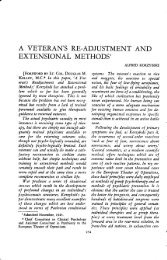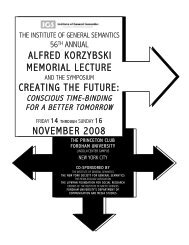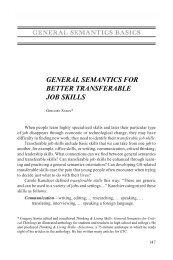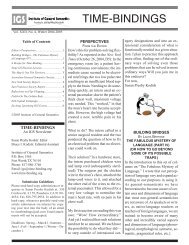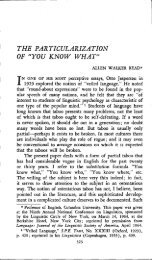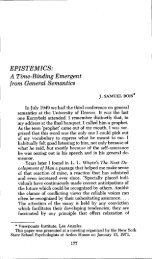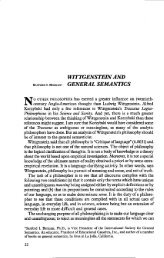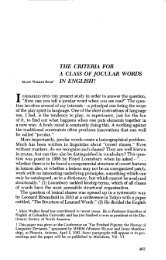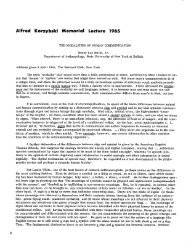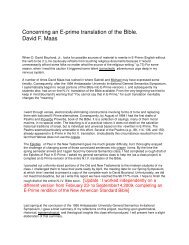j. samuel bois--an appreciation - The Institute of General Semantics
j. samuel bois--an appreciation - The Institute of General Semantics
j. samuel bois--an appreciation - The Institute of General Semantics
Create successful ePaper yourself
Turn your PDF publications into a flip-book with our unique Google optimized e-Paper software.
J. SAMUEL BOIS--AN APPRECIATION<br />
DR. J .<br />
ROBERT WANDERER*<br />
SAMUEL BOIS is clearly, I think, the leading theoretici<strong>an</strong><br />
in general sem<strong>an</strong>tics today, as well as a valuable<br />
<strong>an</strong>d exciting explorer <strong>of</strong> how to apply it .<br />
Bois-it's pronounced "bwa"-doesn't fall into <strong>an</strong>y simple<br />
category. He's neither <strong>an</strong> "orthodox Korzybski<strong>an</strong>" nor "merely<br />
a popularizer," whatever those terms might me<strong>an</strong> . He builds<br />
on Korzybski's foundations <strong>an</strong>d develops insights that I find<br />
extremely useful .<br />
People in general sem<strong>an</strong>tics <strong>of</strong>ten have unusually diverse<br />
backgrounds, but few c<strong>an</strong> match Sam Bois . He started his<br />
career in his native Quebec as a Catholic priest. As a workerpriest,<br />
he org<strong>an</strong>ized labor unions <strong>an</strong>d founded a Catholic<br />
weekly which is still in existence. <strong>The</strong>n, as a missionary, he<br />
worked with Mexic<strong>an</strong>s <strong>an</strong>d Indi<strong>an</strong>s in California . But 14 years<br />
as a priest ch<strong>an</strong>ged Sam Bois, <strong>an</strong>d didn't ch<strong>an</strong>ge the church ;<br />
he was arraigned <strong>an</strong>d condemned before the Holy Office in<br />
Rome, subjected to what he calls "a latter-day Inquisition,"<br />
<strong>an</strong>d finally released from the church .<br />
He returned to college, got a Ph .D . in psychology at Mc-<br />
Gill in Montreal, <strong>an</strong>d joined with <strong>an</strong>other psychologist in the<br />
first psychological consulting service in C<strong>an</strong>ada . During that<br />
time he wrote a monthly column for a medical journal, a<br />
weekly column for a literary <strong>an</strong>d political paper, <strong>an</strong>d three<br />
books in French . <strong>The</strong>n, during World War II, he served as<br />
a lieuten<strong>an</strong>t colonel in charge <strong>of</strong> research <strong>an</strong>d information at<br />
National Defense Headquarters in Ottawa .<br />
In 1939 he "discovered" general sem<strong>an</strong>tics, <strong>an</strong>d when he<br />
* Teacher <strong>of</strong> adult evening classes in general sem<strong>an</strong>tics in the<br />
S<strong>an</strong> Fr<strong>an</strong>cisco area ; past president, S<strong>an</strong> Fr<strong>an</strong>cisco Chapter ISGS, <strong>an</strong>d<br />
editor <strong>of</strong> <strong>The</strong> Map, the chapter's newsletter ; <strong>an</strong>d member <strong>of</strong> the Editorial<br />
Committee <strong>of</strong> ETC.<br />
39 1
ETC. : A REVIEW OF GENERAL SEMANTICS VOL . XXVI, NO . 4<br />
went into industrial psychology after the war, he adapted<br />
m<strong>an</strong>y sem<strong>an</strong>tics ideas into that field, <strong>an</strong>d he developed a m<strong>an</strong>agement<br />
training program called Executive Methods which he<br />
conducted in m<strong>an</strong>y large cities . In 1956 he "retired" <strong>an</strong>d moved<br />
to Southern California, where he serves as director <strong>of</strong> research<br />
<strong>an</strong>d education at Viewpoints <strong>Institute</strong>, a center for general<br />
sem<strong>an</strong>tics study in Los Angeles, <strong>an</strong>d conducts classes <strong>an</strong>d workshops<br />
there <strong>an</strong>d at the University <strong>of</strong> California at Los Angeles<br />
<strong>an</strong>d the University <strong>of</strong> Southern California .<br />
Bois's<br />
major single contribution surely must be his Sem<strong>an</strong>tic<br />
Reactor diagram, with its four ellipses covering the four<br />
kinds <strong>of</strong> activities <strong>of</strong> <strong>an</strong> org<strong>an</strong>ism-thinking (those involving<br />
words or symbols), feeling (those involving emotions), moving<br />
(body movement <strong>an</strong>d muscle patterns), <strong>an</strong>d electro-chemical<br />
(observed mostly through scientific instruments) . <strong>The</strong>se<br />
all affect one <strong>an</strong>other as well as interacting with the environment<br />
around them, with a similar structure for the past <strong>an</strong>d<br />
a similar structure for expectations <strong>of</strong> the future also affecting<br />
the rest <strong>of</strong> the model. This was published in his 1957 Explorations<br />
in Awareness .<br />
Bois continued to refine the concept, <strong>an</strong>d in his 1966 <strong>The</strong><br />
Art o f Awareness he revised the diagram to make the four<br />
ellipses more overlapping, to suggest more clearly the way<br />
each part <strong>of</strong> the org<strong>an</strong>ism effects every other part . <strong>The</strong>n he<br />
took Korzybski's Structural Differential, gave the various levels<br />
new names which seem to make them easier to underst<strong>an</strong>d,<br />
<strong>an</strong>d put miniature Sem<strong>an</strong>tic Reactor diagrams (which I like<br />
to call "Sam Bois helicopters") between levels . <strong>The</strong> result is a<br />
general model which not only demonstrates graphically the<br />
abstraction process but points up more clearly the way each<br />
person filters each level through his own nervous system to<br />
make the abstractions .<br />
His most recent publication, the 1968 "mini-book" Communication<br />
as Creative Experience, sums up Bois's work in<br />
terms <strong>of</strong> practical applications for the average person in communicating<br />
. Another book, Breeds o f Men, will appear in<br />
1970 .<br />
3 9 2
DECEMBER 1969 J . SAMUEL BOIS-AN APPRECIATION<br />
P ERSONALLY, if I had to pick out a single page <strong>of</strong> Bois's<br />
writing as the most useful, I'd choose page 24 <strong>of</strong> Communication<br />
as Creative Experience, where he lists seven ways<br />
<strong>of</strong> communicating effectively . I see Bois here as not only distilling<br />
the practical application <strong>of</strong> general sem<strong>an</strong>tics to communication,<br />
but <strong>of</strong>fering a strong challenge to us as sem<strong>an</strong>ticists,<br />
<strong>an</strong>d incidentally demonstrating his position in the growing<br />
edge <strong>of</strong> general sem<strong>an</strong>tics development .<br />
Some <strong>of</strong> his suggestions are similar to those made by other<br />
writers, although Bois does put them in such a way as to lend<br />
a sort <strong>of</strong> inevitability, a sort <strong>of</strong> "natural sense," to them . He<br />
suggests we accept the person we're trying to communicate<br />
with as he is, <strong>an</strong>d that we encourage him to express himself<br />
freely . He suggests, as I underst<strong>an</strong>d him, that we avoid both<br />
the "let's stick to the problem" <strong>an</strong>d the "I w<strong>an</strong>t to convince<br />
you" h<strong>an</strong>gups .<br />
But while other general sem<strong>an</strong>ticists advocate use <strong>of</strong> a<br />
"to me" or "in my opinion" tossed somewhere in your statement<br />
<strong>of</strong> opinion, Bois sees this as a half-way measure . <strong>The</strong><br />
honest <strong>an</strong>d accurate way, as I read Bois, is to state your feelings<br />
with "I" as the subject, not with "in my opinion" as a kind<br />
<strong>of</strong> afterthought . Using "I" also helps avoid the questionable<br />
use <strong>of</strong> "is ."<br />
I find this suggestion the real blockbuster : "Do not evaluate<br />
critically the other person's views against your own as the<br />
st<strong>an</strong>dard <strong>of</strong> truth <strong>an</strong>d wisdom, but take his views as a tentative<br />
st<strong>an</strong>dard against which you re-examine <strong>an</strong>d re-evaluate your<br />
own opinions <strong>an</strong>d feelings ."<br />
Wow! Not only let other statements into your org<strong>an</strong>ism<br />
uncritically, but actually put them in that cherished spot in<br />
the heart <strong>of</strong> your own belief system, as a way <strong>of</strong> testing what<br />
you believe!<br />
I think this is tremendous, although certainly not <strong>an</strong> easy<br />
thing to do . But it illustrates the kind <strong>of</strong> challenge that Sam<br />
Bois puts down for us <strong>an</strong>d the reason why I find his ideas<br />
so exciting .<br />
3 93




